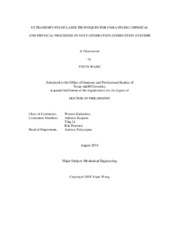| dc.description.abstract | Ultrashort-pulse, femtosecond (fs)-duration laser techniques are powerful tools for investigating physical and chemical processes in reacting and non-reacting flow systems, providing data with high spatial and temporal resolution. Femtosecond laser pulses are advantages over traditionally used nanosecond laser pulses because of the low average power but high peak power as well as high repetition rate provided by amplified fs lasers. The objective of this thesis research is to use fs laser pulses to investigate mixing processes and also image important intermediate chemical species in combustion systems.
The primary work on mixing process studies has been demonstrated using krypton (Kr) as an inert gas tracer. A detailed spectroscopic study was performed to investigate key fluorescence channels followed by the 5p’←←4p, two-photon excitation of Kr using 204.1-nm fs pulses. The experimentally observed spectral line locations agree well with the data in the NIST Atomic Spectra Database in the 750–840-nm emission region, although significant discrepancies in some line strengths were observed. Two-dimensional (2D), two-photon laser-induced fluorescence (TPLIF) images recorded in an unsteady jet demonstrate the potential of using the fs excitation scheme of Kr for mixing and flow diagnostic studies.
In the next part of this thesis research, fs-TPLIF was investigated for detecting carbon monoxide (CO) in flames. Interferences from photolytically produced Cv2 Swan-band emissions show a pronounced effect on CO fluorescence signals in fuel-rich, sooting hydrocarbon flames when using CO fs-TPLIF. Therefore, specific spectral filter is
required to reduce Cv2 interferences for quantitative concentration measurements in such flames. Interferences from nascent Cv2 originating from hot soot particles could be avoided by using a narrower detection gate width. At elevated pressures, CO fluorescence signal resulting from the fs excitation scheme, decays slower than that resulting from the ns excitation scheme. Comparison of the measured CO fluorescence signal with the calculated CO number density shows a good agreement for both premixed CHv4/air and Cv2Hv4/air flames. Subsequently, fs-TPLIF imaging measurements of CO are also demonstrated in piloted liquid-methanol spray flames.
In the final part of this research, fs pulses have been used for planar laser-induced fluorescence (PLIF) measurements of the hydroxyl (OH) radicals in flames. The excitation of the (1,0) vibrational band of the A^2Ʃ^+←X^2Π electronic manifold using single-photon transition scheme has been utilized. The measured OH-LIF signals agree well with the equilibrium calculations in a range of flame conditions. Single-laser-shot, 2D OH-PLIF images recorded at 1-kHz repetition rate in a premixed Cv2Hv4/air jet flame and a turbulent CHv4/Hv2 diffusion flame show the potential of fs-laser pulses for OH imaging measurements in reacting flow systems. | en |


